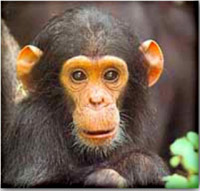AIDS originated in chimpanzees, scientists confirm
The suspected origin of HIV has been confirmed, following the discovery of the simian immunodeficiency virus, which was similar to the HIV-1 strain of the human virus. Perviously, SIV had only been found in captive chimps.

Twenty-five years after the first AIDS cases emerged, scientists have confirmed that the HIV virus plaguing humans really did originate in wild chimpanzees, in a corner of Cameroon.
Solving the mystery of HIV's ancestry was a dirty work. Scientists employed trackers to plunge through dense jungle and collect the fresh feces of wild apes - more than 1,300 samples in all.
Before that, it took seven years of research just to work out the testing methods to genetically trace the primate version of the virus in living wild chimps without hurting the endangered species.
Until now, "no one was able to look. No one had the tools," said Dr. Beatrice Hahn of the University of Alabama at Birmingham. She led the team of international researchers that reported the success in Friday's edition of the journal Science, according to the AP.
It is thought that people hunting chimpanzees first contracted the virus - and that cases were first seen in Kinshasa, in the Democratic Republic of Congo - the nearest urban area - in 1930.
Scientists believe the rareness of cases - and the fact that symptoms of Aids differ significantly between individuals - explains why it was another 50 years before the virus was named.
This team of researchers, including experts from the universities of Nottingham, Montpellier and Alabama, have been working for a decade to identify the source of HIV, BBC reports.
Analysis of the path of the human pandemic has pinpointed Kinshasa as the epicentre of the outbreak. The first HIV-positive human blood was obtained here in 1959. The virus was almost certainly carried here by infected humans, says Paul Sharp, a viral geneticist at the University of Nottingham. - "Chimps don't walk the streets of Kinshasa ."
The theory is supported by the fact that rivers, the primary transport routes through the dense West African jungle, provide an easy means of travelling from southern Cameroon to Kinshasa . Once there, the urban environment would have been far more conducive to the transmission of the virus between people. But it will be a difficult story to verify with certainty. "We're talking about something thought to have happened more than 75 years ago," he says.
It seems to be largely a matter of chance that this strain became the one to terrorize the globe, says Sharp. HIV-2, thought to have come from sooty mangabey monkeys, also causes AIDS in humans, but this virus is confined almost entirely to West Africa, according to Nature.com.
Of the 40 million people living with HIV now, more than two-thirds are in sub-Saharan Africa, which is also home to 77% of the women with HIV.
Last year, there were nearly 5m new HIV infections, 4.2m among adults and 700,000 in children under 15. In the same year, there were 3.1m deaths from Aids, more than half a million of whom were children.
Identifying the source of the HIV pandemic is more than filling in a missing link in the disease's progression. Understanding how the virus infects chimpanzees, and why it does not appear to cause disease in such a similar genetic species, could unveil useful clues about how the virus works in humans and which crucial changes happened to the virus when it made the leap to humans, says Guardian.co.uk.
Source: agencies
Prepared by Alexander Timoshik
Pravda.ru
Subscribe to Pravda.Ru Telegram channel, Facebook, RSS!





